The Serious Eats Field Guide to Asian Greens
How to tell your shoots from your choys.
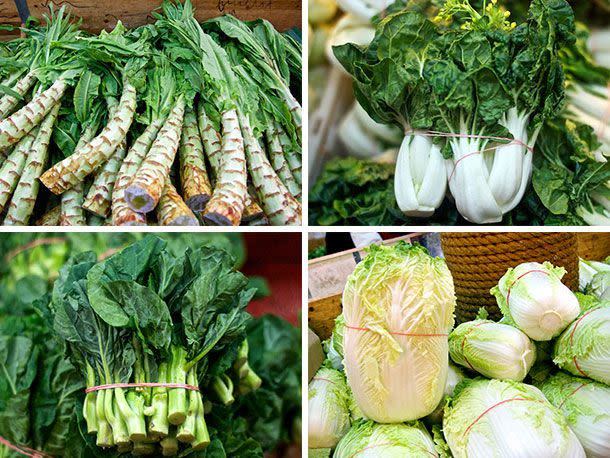
Serious Eats / Ben Jay
When you walk into the produce section of your local Asian supermarket, you'll probably be greeted by a dazzling but daunting display of unusual greens. They're all great, and easy to cook, but it helps to be armed with some knowledge to tell your shoots from your choys.
That's why we highlighted the most common varieties you'll find in Asian groceries with notes on what they are, how they taste, and most importantly, what to do with your haul.
AA Choy
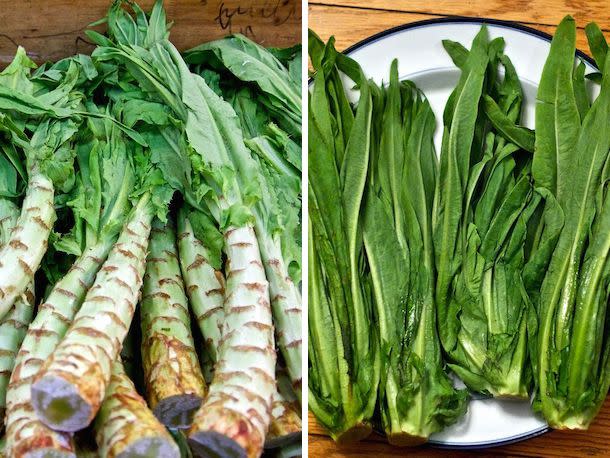
Serious Eats / Ben Jay
AA Choy stalks and leaves.Latin name: Lactuca sativa
Also known as: Taiwan lettuce, AA Chop Xin, stem lettuce, asparagus lettuce, celery lettuce, celtuce, wosun
Flavor: The leaves are similar to romaine, while the stalks taste a little like cucumber. There's a mild bitterness as well.
Texture: The leaves and inner stalk are tender like lettuce; discard the outer stalk.
Best cooked: Stir fry the leaves. Same for the stalks, or you can pickle them. If you're cooking the stalks, peel the outer skin first.
Available: Year-round, but best around late spring/early summer.
Where to find: Chinese and Taiwanese groceries.
Bok Choy
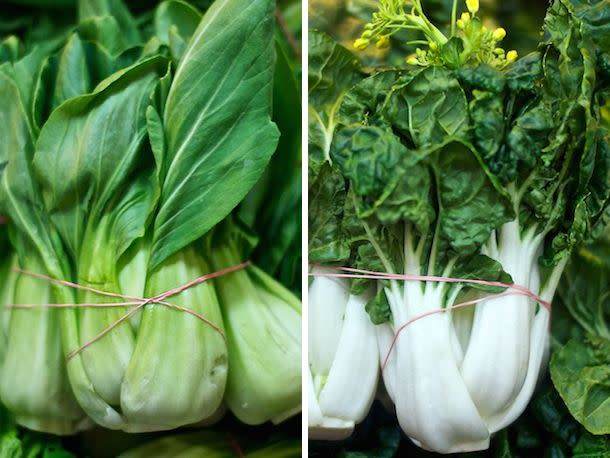
Serious Eats / Ben Jay
Shanghai and baby bok choy.Latin name: Brassica rapa ssp. chinensis
Also known as: Chinese cabbage, pok choi, yóu cài ("oil vegetable" in Mandarin), qīng cài (blue-green vegetable" in Shanghainese).
Flavor: Very mellow, with its own unique mild, peppery spice. Similar to cabbage.
Texture: Bok choy leaves are famously tender and crisp, while the stalks are crunchy, firm and juicy. Depending on the cultivar, the leaves are dark green or yellow-green and the stalks yellow-green or off-white. Bok choy comes in mature and baby sizes. Both are tender, but the baby variety is especially so.
Best cooked: Stir fried, braised, steamed, sauteéd, or simmered in soups. One of the most versatile and widely-used greens listed here. Leaves can be eaten raw in a salad.
Recipes: Bok Choy and Kale Fried Rice with Fried Garlic, Shanghai Baby Bok Choy with Black Bean Sauce, Grilled Bok Choy with Sweet Soy Sauce Glaze, Stir-Fried Bok Choy
Available: Year-round, though the peak season is winter.
Where to find: Available at most Asian markets, especially Chinese groceries. Larger, mature varieties available at many supermarkets.
Chinese Broccoli
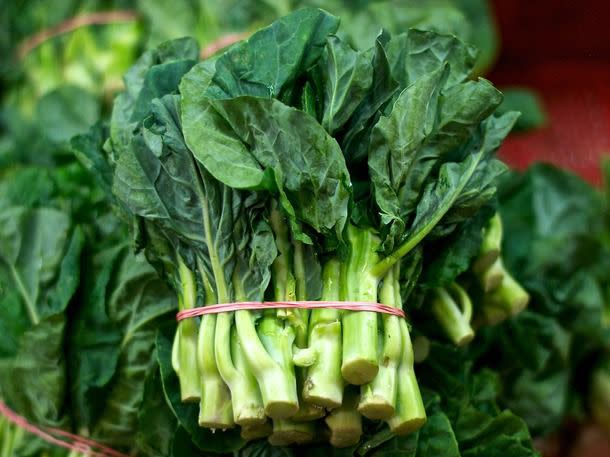
Serious Eats / Ben Jay
Latin name: Brassica oleracaea, Alboglabra Group
Also known as: Gai lan, kai lan, Chinese kale
Flavor: Similar to broccoli, but stronger and slightly more bitter.
Texture: Wide, flat leaves like collards and thick, crisp-tender stalks.
Best cooked: Blanched or steamed (served with oyster sauce), or blanched and stir-fried.
Recipes: Stir-Fried Chinese Broccoli with Crispy Pork Belly (Khana Mu Krop); Chinese Broccoli With Oyster Sauce and Fried Garlic
Available: Year-round.
Where to find: Chinese groceries.
Chinese Celery
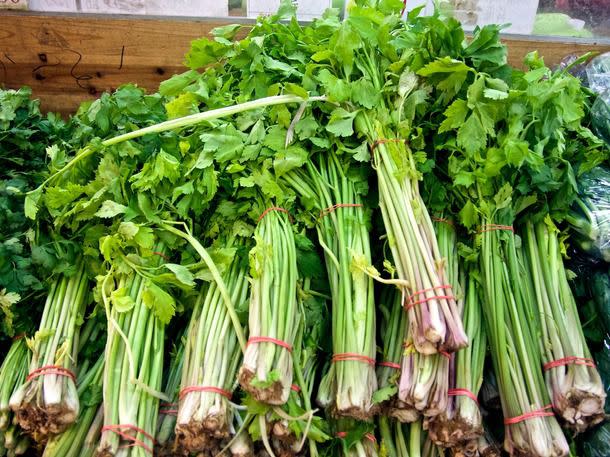
Serious Eats / Ben Jay
Latin name: Apium graveolens var. secalinum
Also known as: Oriental celery
Flavor: Aromatic and grassy, but stronger than common celery.
Texture: Stems are thin, hollow and crispy, but smaller and more delicate than common celery. The feathery leaves are used just as much as the stalks.
Best cooked: Often added to stir-fries and soups, but usually for its flavor rather than its texture.
Recipes: Crispy Kung Pao Tofu, Spicy Stir-Fried Fennel, Celery, and Celery Root With Chinese Sausage; Spicy Warm Silken Tofu with Celery and Cilantro Salad
Available: Best from summer through early autumn.
Where to find: Chinese groceries.
Chrysanthemum Greens
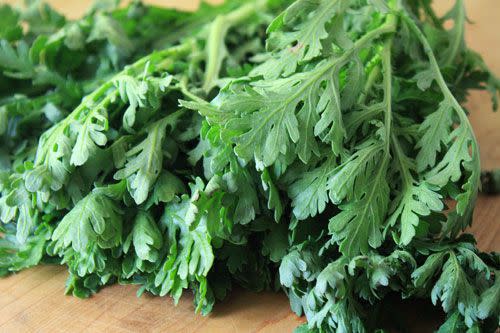
Serious Eats / Chichi Wang
Latin name: Chrysanthemum coronarium
Also known as: Garland chrysanthemum, edible chrysanthemum, chop suey green, crown daisy, Japanese green, tong hao, shungiku, ssukgat, ải cúc, tần ô.
Flavor: A wild but subtle mix of tangy, bitter, herbal, cooling, and grassy. Suitable for anyone who enjoys chrysanthemum tea.
Texture: Soft and feathery, with flat, serrated leaves, and slightly crunchy stalks.
Best cooked: Young greens can be eaten raw, but most sold in markets will be too mature and bitter, and should be lightly steamed or blanched. Tn Japanese cuisine, they're often added to soups or cooked tempura-style
Recipes: Chrysanthemum Greens with Sesame Seed Dressing
Available: Spring to autumn.
Where to find: Most Asian markets: Chinese, Japanese, Korean, and Southeast Asian.
Daikon Greens
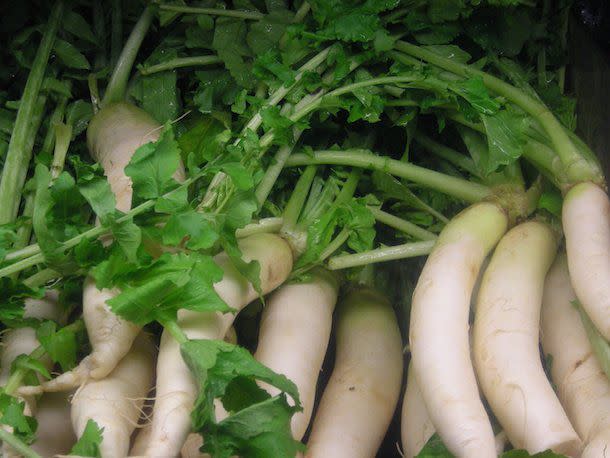
wikioticscan / Flickr
Latin name: Raphanus sativus var. longipinnatus
Also known as: Mooli, Oriental radish, Japanese radish, Chinese radish, Korean radish, lo bok, bai luobo.
Flavor: The leaves are mild, but somewhat peppery and a little spicy, given the mustard-like oil that the plant naturally produces. Flavor varies throughout different parts of the radish: the top part is sweet, while the bottom is more peppery and pungent.
Texture: The leaves are tender but crisp.
Best cooked: In Western cooking, daikon greens are often just used as a garnish, but in Asian cooking, they are often sauteéd, added to salads for flavor, or even pickled in kimchi. The radish can be pickled, served raw in salads or slaws, simmered in soups, or braised with meats.
Available: Year-round, best during the winter.
Where to find: Most Asian groceries, farmers' markets, some supermarkets. Often sold without the greens, but some grocers store the removed greens in the back, and will provide them upon request.
En Choy
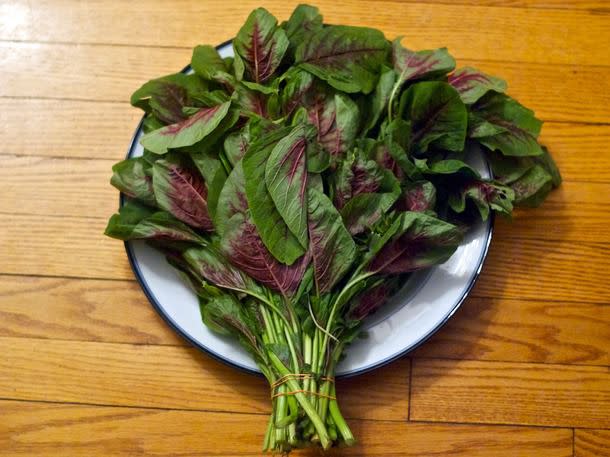
Serious Eats / Ben Jay
Latin name: Amaranthus tricolour
Also known as: Bayam, Chinese spinach, Amaranth, phak khom suan, rau dên, red honchoy.
Flavor: Similar to spinach. En choy is related to beetroot, and its color comes from antioxidants called betalains.
Texture: Crisp leaves and crunchy stalks.
Best cooked: Lightly steamed, stir-fried, or used raw in salad.
Recipes: Spinach Salad with Beets and Walnuts
Available: Spring through autumn.
Where to find: Asian supermarkets, Chinese groceries.
Fava Greens
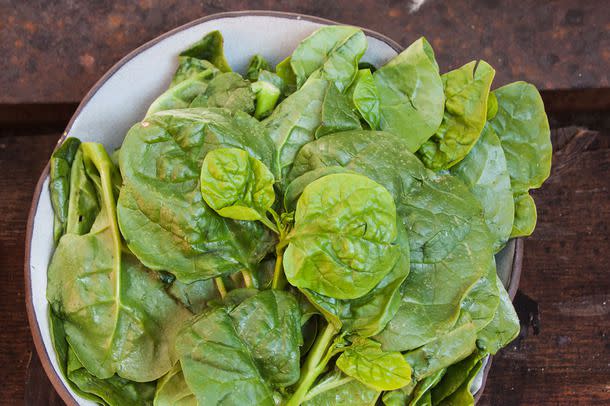
Serious Eats / Lily Chin
Latin name: Vicia faba
Also known as: Broad bean, field bean, bell bean, tic bean.
Flavor: Sweet, buttery, and earthy—similar to fava beans.
Texture: Tender, smooth, buttery.
Best cooked: In Asian cooking, fava greens are commonly used to wrap seafood before cooking, but they also make a great addition to salads and pastas when raw, slightly wilted, or sauteéd.
Available: Late spring through summer, peaking around July.
Where to find: Farmers' markets and well-stocked Chinese groceries.
Kokabu Greens
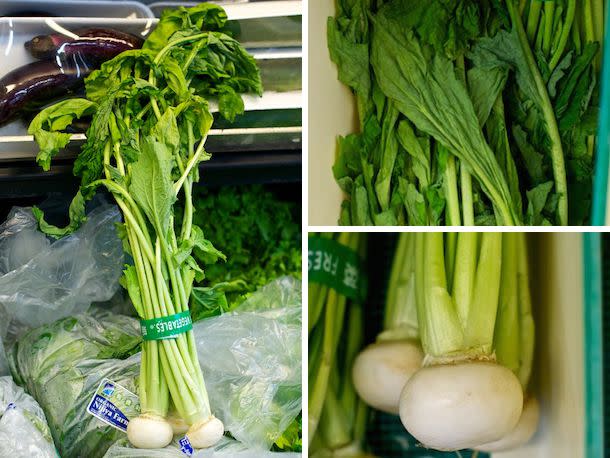
Serious Eats / Ben Jay
Latin name: Brassica rapa ssp. rapa
Also known as: Japanese white turnip, white salad turnip.
Flavor: The leaves are bitter, not unlike mustard greens, but noticeably milder. The turnips are delicately sweet.
Texture: The leaves are bushy, soft, and tender. The turnips have thin skins and are generally small, tender, and finely textured,
Best cooked: Once blanched, the leaves work well in cold vegetable dishes, or as a soup garnish. The turnips can be served in salads and soups, steamed, or pickled. Given their small size, they're often served whole.
Available: Can be easily grown from early spring through autumn. Available in markets from early autumn through early summer.
Where to find: Japanese groceries.
Malabar Spinach
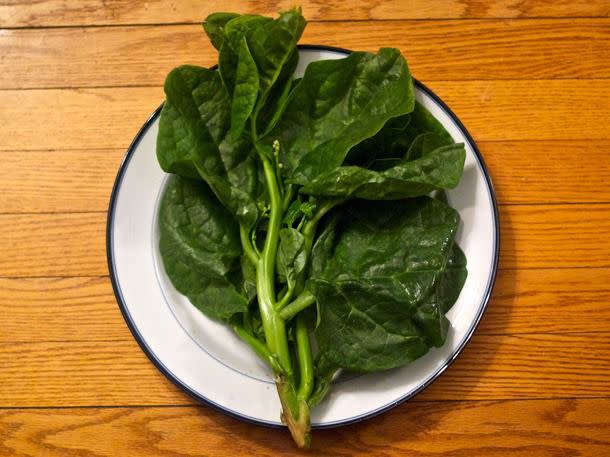
Serious Eats / Ben Jay
Latin name: Basella alba
Also known as: Vine spinach, buffalo spinach, creeping spinach, climbing spinach, Ceylon spinach, red-tipped spinach, poi choy, chancai.
Flavor: Pepper and citrus when raw, like spinach when cooked.
Texture: Juicy and crisp, with thick, fleshy leaves when raw, smooth like spinach when cooked.
Best cooked: Eat them raw in salads, stir fry them, or wilt them in soup or curries.
Available: Grows best during the summer.
Where to find: Mainly Indian groceries, but also some East Asian markets.
Mizuna
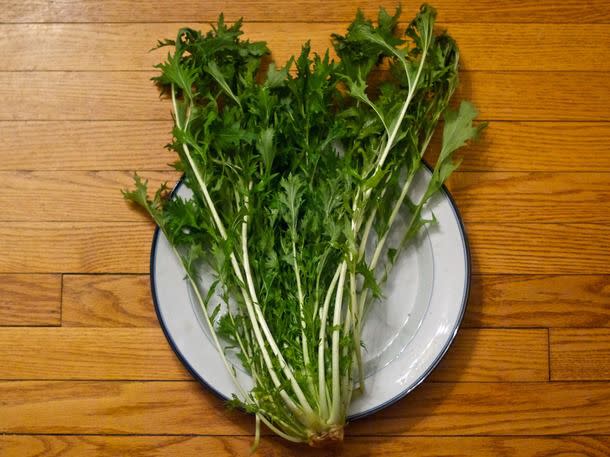
Serious Eats / Ben Jay
Latin name: Brassica rapa ssp. nipponsinica var. laciniata
Also known as: Shui cai, water greens, Japanese mustard, kyona, potherb mustard, Japanese greens, California peppergrass, spider mustard.
Flavor: Bitter, peppery, and piquant, but milder than comparable greens, like arugula, mustard greens, or frisée.
Texture: Feathery leaves with crispy, juicy stalks.
Best cooked: Raw in salads, stir-fried, pickled, lightly sautéed, or cooked in nabemono, Japanese hot pot.
Available: Year-round, best from autumn until late spring.
Where to find: Japanese groceries.
Mustard Greens
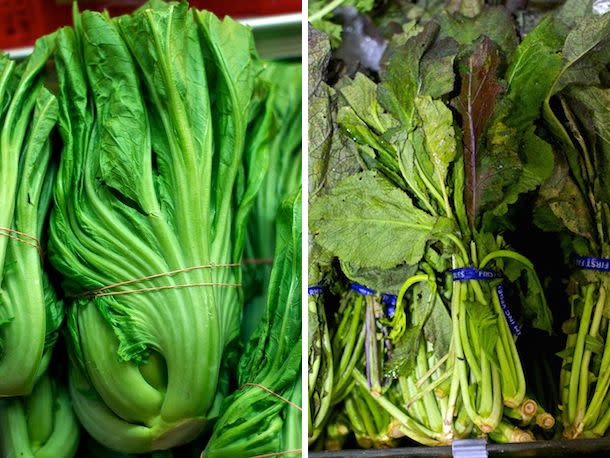
Serious Eats / Ben Jay
Green mustard and Korean red mustard.Latin name: Brassica juncea
Also known as: Gai choy, Chinese mustard, Indian mustard, leaf mustard.
Flavor: Mustard greens have a distinctively sharp, pungent bite, while red mustard's flavor is reminiscent of wasabi. The strong flavor (and red mustard's distinctive color) are lost if overcooked.
Texture: The crunchy leaves have a frilly, ruffled texture. Moderately tender.
Best cooked: Steamed, braised, sauteéd, or stir-fried. Blanching before cooking mellows the strong flavor. Baby mustard greens work well in salads.
Available: Best during the winter through early spring.
Where to find: Readily available at most Asian markets, especially Chinese groceries, and some specialty supermarkets.
Napa Cabbage
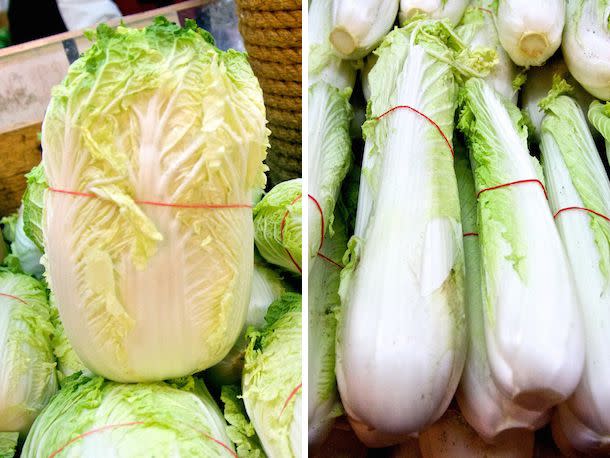
Serious Eats / Ben Jay
Napa and michihili cabbage.Latin name: Brassica rapa ssp. pekinensis
Also known as: Chinese cabbage, Chinese white cabbage, wombok (especially in Australia), baechu, wongbok, hakusai. Longer, narrower variety sometimes known as Michihili.
Flavor: Delicate, mild, and somewhat sweeter that common green cabbage.
Texture: Watery, firm, and crunchy, with fat stalks. The leaves are thinner than green cabbage but thicker than savoy. Tender and juicy when slow cooked.
Best cooked: Stir-fried, wilted in soup, boiled in hot pot, pickled in kimchi, and minced as a filling for Chinese dumplings. Also good raw and shredded fine, especially in salads, slaws, and wraps.
Recipes: Japanese-Style Pork and Cabbage Dumplings; Kimchi Chicken and Cabbage Stir-Fry; Kale and Cabbage Gratin
Available: Year-round.
Where to find: Readily available at most supermarkets and Asian groceries.
Snow Pea Leaves

Serious Eats / Chichi Wang
P. frutescens var. frutescensLatin name: Pisum sativum var. saccharatum
Also known as: Snow pea tips, snow pea shoots.
Flavor: Refreshing like snow pea pods, but grassier, fresher, and flavorful enough to be cooked without aromatics.
Texture: The stalks are crisp and hollow, while the leaves are tender.
Best cooked: Stir-fried, steamed, or added to soups.
Recipes: Stir-Fried Snow Pea Tips
Available: Year-round, best from early spring to early summer.
Where to find: Chinese groceries.
Tatsoi
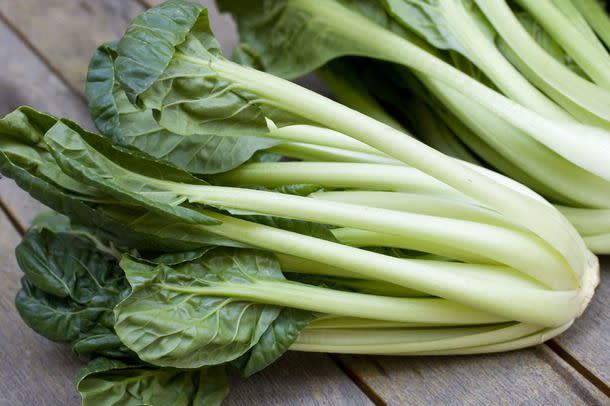
Jessica and Lon Binder / Flickr
Latin name: Brassica narinosa
Also known as: Spinach mustard, spoon mustard, rosette bok choy, Japanese spinach.
Flavor: Slightly bitter, like mustard greens, but milder.
Texture: Thick, dark green leaves with crisp, juicy stalks, not unlike bok choy.
Best cooked: Added to soups, stir-fried, or sauteéd. Young tatsoi works well raw in salads.
Recipes: Steamed Walleye with Tatsoi, Ginger, and Scallions
Available: Year-round.
Where to find: Farmers' markets and Asian groceries.
Water Spinach
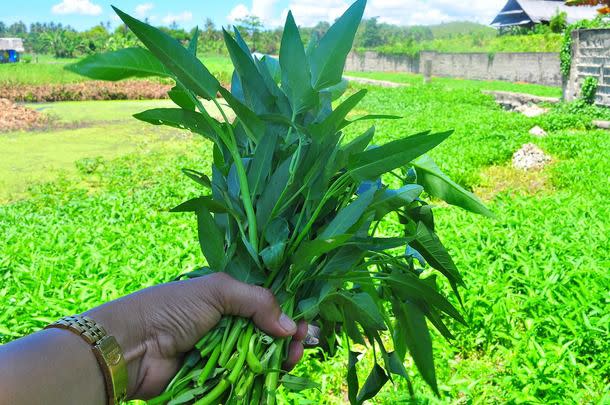
Kuya Raycoy / Flickr
Latin name: Ipomoea aquatica
Also known as: Kangkong, ong choy, river spinach, water morning glory, water convolvulus.
Flavor: Very mild and slightly grassy, with some nutty undertones.
Texture: Distinctively crunchy, which holds up remarkably well even when cooked. The hollow stems drink up cooking liquid.
Best cooked: Steamed and topped with oyster sauce, stir-fried, cooked into soup, eaten raw in salad, or sometimes in curries.
Available: Best during the summer.
Where to find: Southeast Asian or Chinese groceries.
Yu Choy
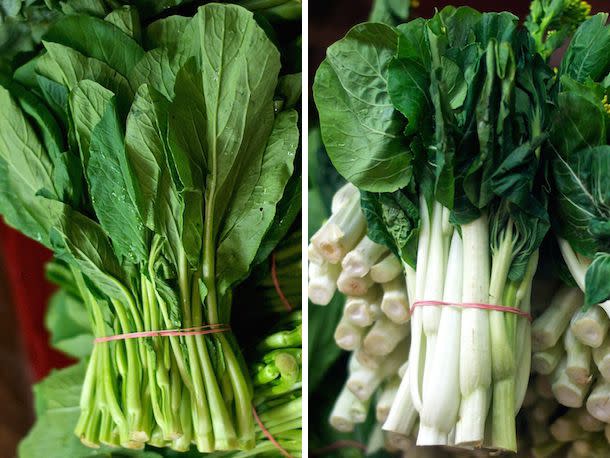
Serious Eats / Ben Jay
Yu Choy and choy sum.Latin name: Brassica rapa var. parachinensis
Also known as: Chinese oil vegetable, you cai, yao choy; younger varieties often labeled choy sum.
Flavor: Slightly bitter, earthy, mustardy stems. Leaves and small yellow flowers are also edible. Complements aggressive flavors well when stir-fried.
Texture: Thin, crunchy, tender stalks.
Best cooked: Can be used in many recipes in place of bok choy. Thick stems should be peeled and trimmed.
Available: Year-round, grows spring through autumn.
Where to find: Chinese groceries.
May 2014
Read the original article on Serious Eats.
